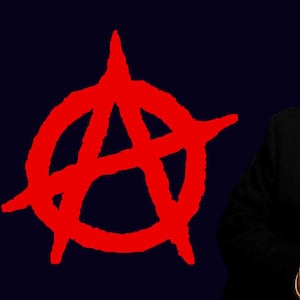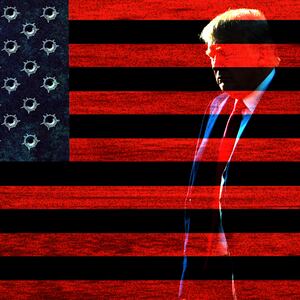Donald Trump is running for re-election on a platform of recklessly encouraging citizens to risk death to “reopen” the economy, while he foments state violence and encourages a race war.
While many have struggled to discern a politically savvy strategy underlying Trump’s now overtly nihilistic message, there may not be one. Over the several years of his presidency, Trump has incrementally, but by now, quite definitively, embraced a set of policy positions that are authoritarian, racist and indeed fascistic.
And as a candidate for re-election, Trump is now facing the challenge of defending those policies, regardless of how repugnant—and indeed how unpopular—they have proven to be.
ADVERTISEMENT
In the last several days many have, appropriately, drawn analogies between Trump and George Wallace, the former Alabama Governor who had remarkable, but ultimately limited, success taking his celebration of state racism on the road to Michigan and other Midwestern states as an independent candidate for president in 1968.
Before entering the national arena, Wallace had gained notoriety for his defense of using law enforcement officers as shock troops, charged with unleashing violence on African-American civil rights activists. As the cities of the North began to burn relentlessly following the assassination of Martin Luther King in 1968, some whites who feared an imminent race war found Wallace’s message compelling.
Wallace’s campaign, however, came up short, as did his subsequent efforts at national office. While there was a substantial constituency among a still overwhelmingly white electorate for an overtly racist candidate advocating state violence, most voters remained wary of, at least openly, endorsing a policy that was not only morally repugnant, but also—perhaps more disturbingly—promised to meet disorder with an even greater level of violence, and thus potential chaos, for the nation.
That is where Richard Nixon’s luck, and political brilliance, took over. With the help of skilled political advisers including Roger Ailes, Karl Rove, as well as a young Roger Stone and—most importantly—Pat Buchanan, Nixon appropriated Wallace’s campaign themes and policies, including and especially his appeals to nativism and racism. But Nixon did so with a critical difference. While Wallace openly promoted state violence and conflict, Nixon consistently presented himself as the agent of “law and order,” the man who would end the war in Vietnam and prevent one at home, albeit by using heavy doses of force when required.
That distinction was critical to Nixon’s political success, which culminated in his landslide re-election in 1972, appealing to what he (frankly, in many ways correctly) described as the “silent majority” of Americans who craved a nation that pulled back from the brink of chaos, not incidentally while decisively pushing back against the demands of African-Americans for legal and economic justice.
While Watergate ended Nixon’s presidency, his politics provided a template that Republican candidates, many advised by one or more of Nixon’s Svengalis, pursued for decades, in which racist messaging and the promotion of the weighty use of law enforcement were deployed, but in the service of a message of preserving order and preventing the nation from a descent into chaos—not Wallace’s promise of a government openly and notoriously fomenting and promoting such chaos.
When he entered office, Donald Trump appeared to be attempting, however crudely, to reenact Nixon’s silent majority strategy, which he doubtlessly remembered well from his own youth. Trump’s commitment, in his inaugural address, to speak for the “forgotten men and women of our nation” harkened directly back to Nixon’s silent majority message. But Trump’s portrayal of an America in a state of near chaos and a site of “carnage” seemed odd to most Americans, given that, when Trump took office from President Obama in 2017, the nation was on an economic upswing, and few anticipated the need to be saved from disorder, as Nixon had promised in 1968.
But, as it turned out, Trump himself, whether by design or proclivity, proceeded as president to implement a series of policies that increasingly plunged his government, and the nation, into the very sort of conflict, violence, and ultimately literal carnage and civil disorder that he entered office promising to cure.
Trump has consistently managed to focus the nation on his outrageous, and frequently vile, rhetoric, as well as the chaotic and lazy style of his governance. But underlying that disturbing surface Trump has pursued an even more disturbing set of policies, the full import of which is only becoming clear to the nation (and one might suspect, sometimes Trump himself), as the president prepares to defend his record in advance of the election.
First, Trump has built a coalition that integrally embraces fascists and avowed racists. The lynchpin moment for this aspect of Trump’s presidency was Charlottesville, when, in the wake of a gathering of a motley crew of neo-Nazis, Klan members and other sewer dwellers that culminated in the murder of an innocent, Trump declared the racist thugs to be “very fine people.”
One can debate what led Trump to his belligerent embrace of such racists, but it is likely he believed the Klanners, Nazis and their fellow travelers, had been key to his electoral success, and could not prudently be jettisoned as a matter of political strategy, regardless of their murderousness. Whatever the “reasoning” of Trump’s addled and corrupted mind, his choice to stand with murderous bigots was a crossing of the Rubicon for the president. After that, Trump and racist warriors were, literally, one.
From that point forward, it was all but inevitable that Trump would continue to stand by these latter day brownshirts no matter how repugnant their conduct might be.
Some may have been shocked when, in the midst of the pandemic, Trump openly cheered militia members as they descended on state capitals, long guns and grenade launchers in tow, to terrorize public officials and even hang them in effigy. But, given that Trump long ago chose to put in his lot with these motley shock troops, he had little choice but to valorize them, even as they yelled in the faces of police officers, potentially infecting them with a deadly pathogen.
Second, Trump made another fateful policy choice, effectively even before the beginning of his presidency: endorsing gun fanaticism. Faced with incidents like the 2017 mass shooting, largely of white vacationers, in Las Vegas, as well as the October 2018 high school shooting in the prosperous suburban town of Parkland, Florida, Trump initially made noises about taking limited, and overwhelmingly popular steps, to enact gun safety laws, including universal background checks.
But each time, Trump rapidly rejected his own suggestions after being reminded by the NRA that the base of his 2016 victory included the small number of Americans who believe the “right” to own personal armories outweighs any American’s interest in personal safety, regardless of the resulting carnage.
Trump has by now discarded even the pretense of endorsing any gun safety efforts, and instead has taken to routinely advocating the most radical, and paranoid style of pro-“Second Amendment” rhetoric, including cheering on his militia allies as they parade around claiming that “Democrat” public servants are lying in wait to confiscate their ample supplies of ammunition and semi-automatic weaponry.
The problem for Trump is that once again he’s adopted policies putting him squarely at odds with most of the nation. The NRA is now embattled and descending into insolvency, as its radical policies are increasingly discredited politically. For example, while Trump’s praised the gun nuts who have descended on Richmond, Virginia to protest recently enacted, modest, gun safety reforms in that state, it was advocacy for those very reforms that allowed the Democratic Party to take control of both houses of the state legislature and retain the governorship, making a previously heavily Republican state solidly Democratic for the first time in decades. The same result may well occur elsewhere in the next election cycle.
Third, Trump’s embrace of a radical anti-regulatory and anti-science policy agenda—one that makes Ronald Reagan seem like a big government liberal—has rendered him simply unable to effectively lead the country in the midst of the pandemic. By now it is well documented that Trump dismantled or disregarded the scientific institutions that stood ready to advise him on how to avoid a disaster at the outset of the coronavirus pandemic. But, while Trump eventually stumbled to an apparent embrace of rational, science-based public health measures, Trump and his administration are actively opposing the very public health measures the president ostensibly, and belatedly, endorsed.
Trump’s opposition to his own public health measures to “stop the spread” have not been just rhetoric, such as tweets calling for “liberation.” The Department of Justice under Attorney General William Barr—a long-time, committed advocate of Trump’s war on the government itself—has been embarked for weeks on a legal bullying campaign designed to pressure mayors and governors to stop following the guidelines of Trump’s own CDC and, “open up” their cities and states to the virus.
The campaign may have culminated Friday with a DOJ brief filed in federal court frivolously challenging as “arbitrary” and “irrational” a stay-at-home order that the governor of Michigan imposed in plain accordance with the rationales and guidelines recommendations of the Coronavirus Task Force chaired by Trump’s own vice president. The brief is unlikely to have any legal impact (indeed, on Friday night, the Supreme Court rejected a challenge to the application of such scientific guidelines to houses of worship, based on similarly weak legal theories that Barr’s DOJ has also supported).
But Trump’s campaign against his own public health guidance is not only legally doomed, it is also politically incoherent. As polling consistently shows, the majority of the public, and particularly the older voters who are key to Trump’s putative “base,” have no interest in taking up Trump’s call to “open” themselves up to infection without reliable and medically supported measures to protect their health. Accordingly, Trump’s ongoing war with science, once again, leaves him at odds with the very voters he needs to win.
Finally, and most relevant to the current moment, there’s Trump’s embrace of pro-police violence policies. Trump entered office in the wake of a nascent, and initially successful, effort by the DOJ under the leadership of Obama administration Attorney General Eric Holder to pressure, and at times work cooperatively, with, local law enforcement agencies across the nation to improve policing practices, and prevent unnecessary uses of force and illegal detentions.
Trump's first AG, Jeff Sessions, threatened to void already existing voluntary agreements between two cities and the DOJ to reform policing practices. While that effort failed, Sessions and even more aggressively, Barr after him, have caused the DOJ to make an about face, from the federal government’s previous policy of seeking to prevent dangerous police abuses to one that effectively endorses them.
As he left office, Sessions issued a memo formally limiting the employment of injunctions to prevent abusive policing. Barr has since suggested that abusive police practices are actually the product of citizens’ lack of “respect” for the officers who attack them. Accordingly, at this point, when the DOJ declares it is commencing a civil rights investigation of the use of force by police, as Barr says they are doing in Minneapolis, community members have little reason to credit the department’s claim of good faith. Public confidence cannot have been bolstered when Trump appeared to all but ignore the demands for justice from members of George Floyd’s family during a recent call.
This is the record Trump must stand on as he seeks reelection, and it is not only an abhorrent, but an unpopular one, as both the pandemic and now the eruption of protests against police violence have underlined.
Trump’s political, let alone normative, crisis was exemplified by the tweets he has emitted in the wake of protests, and in some cases violence, that occurred across the nation—and in front of the White House—over the past several days, in the wake of the police murder of George Floyd in Minneapolis.
Trump’s near word-for-word repetition of Wallace’s 1968 endorsement of police riots, “looting leads to shooting,” first signaled his intentions, but they have become clearer since.
Saturday morning, Trump issued a series of tweets declaring, with apparent glee, that the Secret Service stood ready to engage in what sounded like a presidentially imagined attack on demonstrators who gathered outside the White House. On Trump’s account, agents had assembled “vicious dogs, and [the] most ominous weapons I have ever seen” to “greet[]” the protesters. Reading his colorful description of these preparations for law enforcement violence left a reader with a distinct impression that the president was unhappy that the Secret Service did not have occasion to let loose the dogs, just as Birmingham, Alabama, Sheriff Bull Connor did upon civil rights activists in 1963.
Trump’s desire to see an actual battle erupt outside the White House was made all the more clear in another tweet, in which he openly called upon his “MAGA” allies to come to Washington to confront those protesting police violence. That call went out to the “fine people” who have previously marched in Charlottesville and, more recently, engaged in armed occupations of state capitals, on Trump’s behalf. Apparently, such a cataclysm was voided when law enforcement officers blocked off the area surrounding the White House from demonstrations on Saturday.
It is not difficult to discern the cynical, and indeed desperate, political calculation of the president. As he stares a likely ignominious electoral loss in the face, Trump must hope that, like Nixon, he can turn the nation’s fear of disorder and racial violence in his favor, presenting himself as a leader who will save the nation with the strong hand of “law and order.”
Trump’s desperation is pathetic, but, in retrospect, it is also inevitable. After all, as a direct result of the policies he has pursued as president, in three short years, the very carnage and chaos that he promised to save the nation from has actually come to pass, but as a result of his own catastrophically dangerous and irresponsible policies.
It is therefore appropriate that, in a time of grave national crisis, the response of the president has been to go full George Wallace, and to openly long for the besieging of the White House, while he remains inside, in the hope that the resulting cracking of heads will somehow bring the nation back to his side. But it’s very difficult to openly arson a building and then obtain credit for the later extinguishing of the fire.
At least Trump’s irresponsible conduct has made matters clear for voters. In November, the nation will be faced with a choice that is more stark than that presented in any election of recent memory, that is: whether the nation will endorse an overt racist and promoter of state violence for a second term in office.








